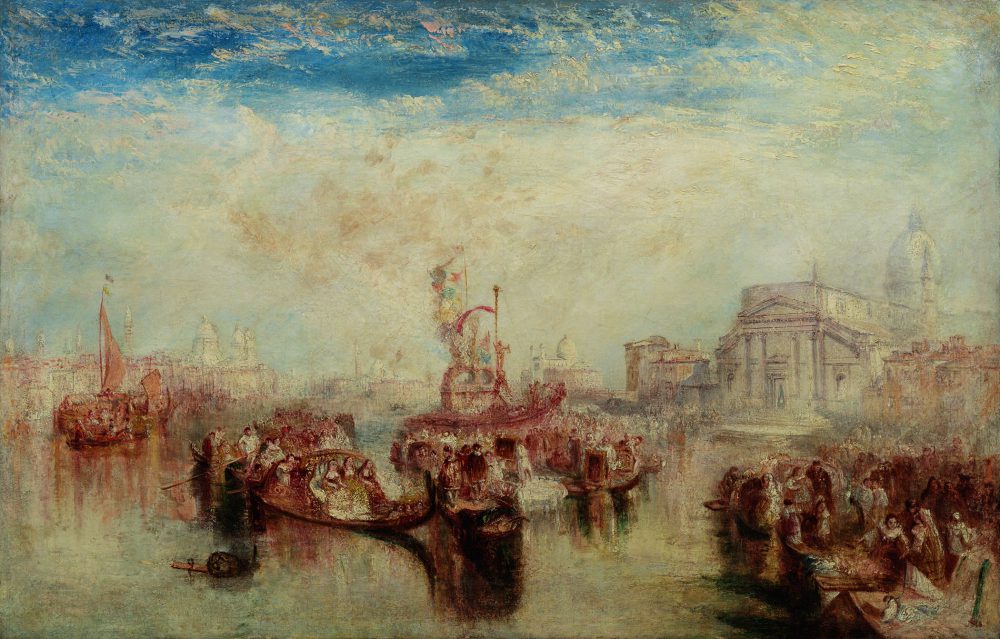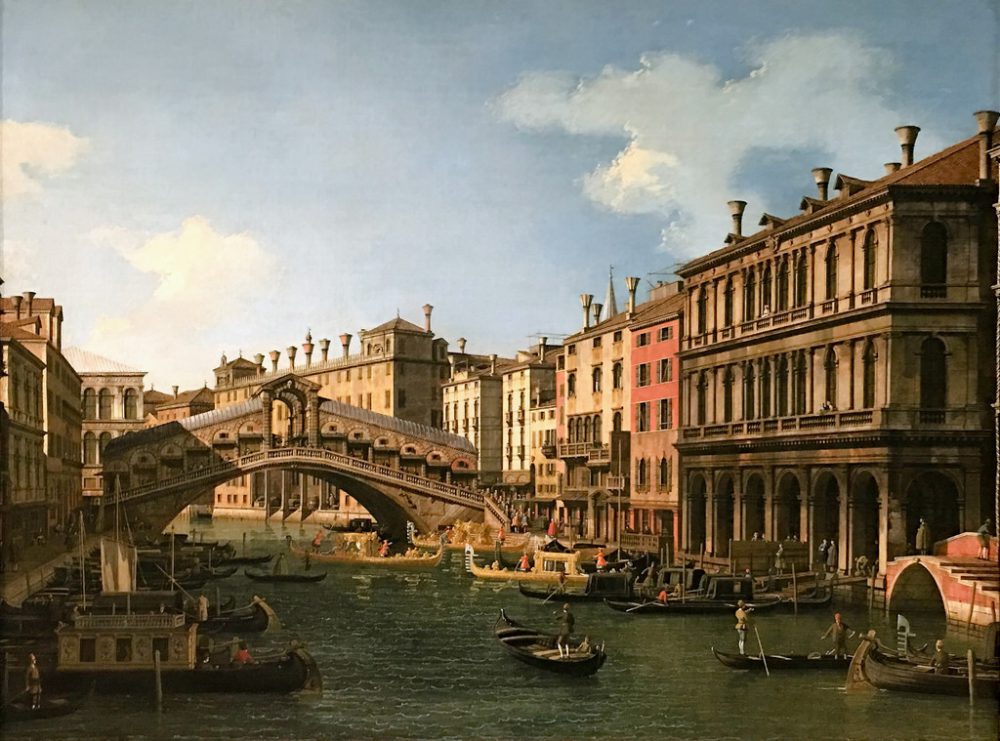Dead Reckoning: The Waterways of Turner and Canaletto
Laurence Ross reflects on two historic views of Venice, Italy, in “Seeing Nature” at the New Orleans Museum of Art.

Joseph Mallord William Turner, Depositing of John Bellini’s Three Pictures in La Chiesa Redentore, Venice, 1841. Oil on canvas. Courtesy the Paul G. Allen Family Collection.
It is simply this, that when you reach the place called the end of the world, you fall off into the water. Some pilgrims drown, some do not. Claro.
Anne Carson, Plainwater
Landscapes can be difficult. Where to look? Where to go next? Like a pilgrim, we can become easily lost. I confess: A landscape rarely captures my attention like a good portrait or compelling figure painting. In the Pussino room at the Palazzo Doria Pamphilj, located in the center of Rome, landscape paintings stack from chair rail to ceiling like wallpaper, the individual works less important than the overall effect of view upon view in the space. And, without guidance and effort, I do tend to think of landscape painting as a decorative art. However, as with any artwork that may prove reluctant to yield something more, an entrance point is essential. As Anne Carson says in her essay “Kinds of Water,” “An entrance is important to a pilgrim: there can be only one.”
“Seeing Nature,” a traveling collection of landscapes by well-known masters from the Paul G. Allen Family Collection, is now on view at the New Orleans Museum of Art. The pieces are arranged in chronological order, with works dating back to Jan Brueghel the Younger and spanning to Georgia O’Keeffe, David Hockney, and beyond. One could easily stroll through the galleries, passing from a cluttered 17th-century painter’s workshop to the Grand Canyon as if time and space were entities into which we could simply dip a toe. And though this hopscotch approach to an exhibit will certainly get you from one point to another, making sense of it all beyond a timeline can prove difficult.
In the older works of Jan Brueghel the Younger, our entrance point is firmly established in history, mythology, and allegory. By the time we reach the Impressionists (Monet, Cézanne, Signac, and Manet as the obvious predecessor), most of us have a readily available entry point for understanding the view—more often than not en plein air painting that prioritizes variances of light and essences of mood over a more direct representation. However, the paintings on view by Canaletto and J.M.W. Turner occupy a middle ground that not only deserves but demands a more thorough exploration to make sense of the gap. Turner’s painting is particularly interesting because it serves as a sort of hinge between accurate representation and the artist’s need to emote.
Though Turner’s Depositing of John Bellini’s Three Pictures in La Chiesa Redentore, Venice, 1841, is not literally in the middle of the show, the painting does seem at its meditative center. This work possesses the same musings on perception and atmosphere as Turner’s most iconic works: Here, the textured whites of the clouds, buildings, water, and clothing all seem cut from the same cloth. Faces are no more than a smudge. Water dissipates from Venetian canal to fog to cloud—and the illuminated veil that is created is the action of the piece, rather than the procession of people and boats happening beneath. Though the title would suggest Turner’s focus is the three paintings by Bellini, the frames are barely discernable in the melee of the crowd. Lines blur rather than solidify, and the architectural details of Il Redentore church deteriorate at the edges.
Turner is ambitiously interested in doing justice to intangible borders and moments of change: light and sky, sky and water, form and reflection. He allows the circumstance of atmosphere to trump the delicate nuances of human pomp, and consequently, the mundane can take on a transformative quality. What, exactly, is being celebrated in this scene? How can the viewer pierce the veil and appreciate what Turner has created? Within this landscape that resembles reality but also feels alien, there is a reckoning that must take place to get one’s bearings, to glean some understanding.
In his book Modern Painting and the Northern Romantic Tradition, Robert Rosenblum highlights “Turner’s isolation of nature’s primordial elements—light, energy, elemental matter.” Though the architectural particularities of Venice and its waterways have served as a muse for many an artist over centuries, what is most noteworthy in Depositing of John Bellini’s Three Pictures is the seeping of a gondola into the ghost of its reflection, signaling how water in all its manifestations is something through which these people persevere. “Even within the precincts of inhabited, cultivated landscapes, masters like Friedrich and Turner could project an aura of mystery that began to tread upon otherworldly realms,” notes Rosenblum, and indeed there is a distinctive distance between the sensational, sensory experience of the world Turner projects and the day-to-day one in which we live. How often do we look beyond the parade of human activity to all that churns above our heads?

Canaletto (Giovanni Antonio Canal), The Rialto Bridge, Venice, from the South with the Embarkation of the Prince of Saxony during His Visit to Venice in 1740, c. 1740. Oil on canvas. Courtesy the Paul G. Allen Family Collection.
At NOMA, directly across the room from Turner is a Venetian landscape by Canaletto, which at first glance seems comparatively uncomplicated and obvious in intent. Indeed, these paintings appear to hang both physically and ideologically opposite. With Canaletto’s focus on architecture and design, The Rialto Bridge, Venice, from the South with the Embarkation of the Prince of Saxony During His Visit to Venice in 1740, painted that same year, conveys a decidedly academic interest in the structure of the city. Such landscapes are often referred to as vedute—Italian for view—and suggest objective truth begotten from fine detail. Shutters, columns, capitals, and smokestacks stand on the bank-less canal with a geometric precision that evokes the rigor of a ruler and compass. Though the subject of the painting ostensibly includes “the embarkation of the Prince of Saxony,” only the golden hue of the gondola in question betrays that a royal affair is taking place. The Rialto Bridge remains the focal point. And though there are clouds in the sky and a sun out of frame, Canaletto’s use of the celestial simply underscores the manmade wonders of a most unnatural landscape with bright, slanted light and shadow. Even the gondolas are painted perfectly straight where the hull meets the canal, an artistic artifice that raises the question of scientific accuracy.
The show places these paintings in the same room because of subject—landscapes of Venice. But this relationship is not their most interesting one. Canaletto’s painting, completed one hundred years earlier, stands in stark contrast to Turner’s embrace of untouchable atmosphere—and, consequently, the unknowable horizon that lies beyond. The two paintings are certainly of different artistic movements, but each still portrays a skewed reality. With Turner, the departure is obvious; with Canaletto, less so. Ultimately, both Turner and Canaletto are interested in portraying a vision of reality different from our own—a much more subjective vision than we might first realize.
It seems obvious that Turner is provoking the viewer and challenging the way in which we typically view weather, the atmosphere, and the elements. Canaletto is provoking as well, though more subtly. With Turner, we may wonder at nature. We can see some aspect of our environment that blends borders and makes discerning what belongs to what more difficult. As Rosenblum notes, “Such a capacity to translate the natural into the supernatural is one thing, among many, that decisively separates Turner’s analysis of shimmering light from that of the Impressionists.” With Canaletto, we may wonder at man. Though it is easy for the viewer to focus on Canaletto’s meticulous architecture, rarely do we take in the world with such precision. However much Canaletto values order, humans are decidedly an unruly, messy bunch prone to fault and error, calling into question whether the exactness of Canaletto’s image of Venice could even be possible.
Standing between the two paintings, these differing visions are rendered all the more clear—each way a departure from our daily lives. For a moment, we can luxuriate in this escape, but the difficulty with escapism is that it is so very difficult to sustain. Eventually, one is deposited back into reality, like silt at the delta.
Let me clarify: I do not consider these landscape paintings escapist. They are not, as Wordsworth says of writing written solely for provocation’s sake, “gross and violent stimulants” to transport us from our reality. Rather, they disturb, disrupt the senses, as he would suggest art of any value would. Rather than lulled to fantasy, the most valuable art shakes us wide awake—and Turner was interested in those moments when the mundane suddenly yields a profound change. My hope, upon seeing this show, was that the disruptions found on those canvases would be more pleasant to consider than the disruptions happening around the country, that considering the presidential election, mounting racial tensions, a rise in hate crimes, and reactionary riots so close to home could be put off a couple hours. My hope was that by looking at the art of the past, I could feel comfortable with the idea of the future. I stood and stared at the scenes of Venetian canals, seeking transport.
However, in the end, these landscapes offer merely the illusion of an escape. When one is standing in front of a painting, taking in technique, color, skill, one cannot steer clear of reality for very long. Even though these paintings were made long ago, our experiences of such artworks are indicative of the present—a strange phenomenon. Fog is in the real world and fog obscures. We seek entrance into art as we seek an entrance (and an exit) to all forms of disruption, whether they are political, social, or otherwise. (Anne Carson says, “Kinds of water drown us. Kinds of water do not.”) We seek a tether to ground ourselves, to keep from going adrift. We seek a way to stand in front of something—sometimes a painting, sometimes the real world—and then make sense of it ourselves. Yes, there are of course other issues at play, but finally the main question is: How do I look at this? That process—and these landscapes—can be beautiful, even when we cannot clearly see the horizon.
Editor's Note
“Seeing Nature: Landscape Masterworks from the Paul G. Allen Family Collection” is on view through January 16, 2017, at the New Orleans Museum of Art (1 Collins C. Diboll Circle).



